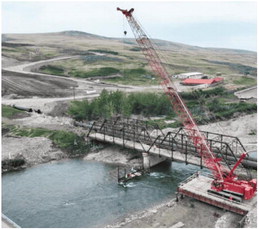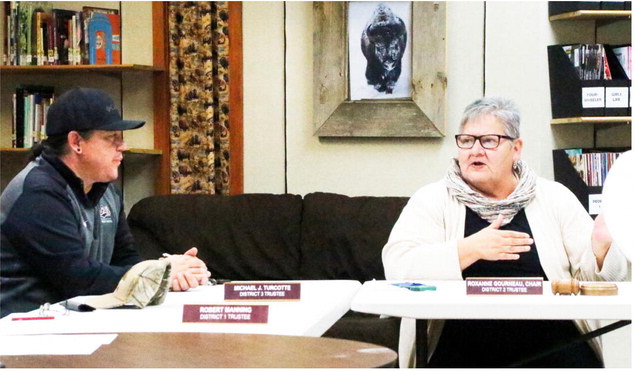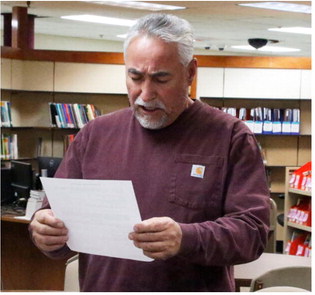As Milk River Dries Up, Federal Funding Process Slows Down


In places, the Milk River has gone dry. Locals say the 350-mile lifeline of the Hi-Line is doing exactly what’s expected without the massive infusion of water that the now-broken plumbing of the St. Mary Siphon once delivered.
The economic losses of an expected two full growing seasons without normal irrigation are already being felt.
“We only got to irrigate 50% of our acres the second time this year, so we already took a pay cut in terms of productivity,” said Marko Manoukian, who farms near Malta and is co-chair of the working group charged with rehabilitating the now idled irrigation system.
Once the 8-foot-diameter pipes feeding water to the Milk blew apart in June, Manoukian knew dry riverbeds were in the future for the 18,000 Montana residents who depend on the Milk River for water. Old-timers say the Milk would run dry six out of 10 years without the boost from the St. Mary siphon.
The siphon is a mega-project from the turn of the last century. Through a diversion dam and several miles of straight pipe and chutes, the project reroutes St. Mary River water bound for Canada near Babb into the Milk River, which then delivers water for drinking and irrigation all the way to Glasgow, a 353-mile drive to the east on U.S. Highway 2.
Also down to a trickle is a promised $275 million from Congress for repairs. Congressional staffers say it’s unlikely a bill will pass until after the general election. House and Senate bills to provide the funding require work, and workdays between now and the election are scarce. The House, where the funding needs a floor vote and a larger bill to piggyback onto, is in session for 13 days between now and Nov. 11. The Senate, over the same period. is in session for 15 days.
There’s also gamesmanship over denying wins to political opponents ahead of the election, according to congressional staffers who asked for anonymity in fear of retaliation for speaking publicly. In the Senate, where the reelection fate of Montana Democrat Jon Tester could determine which party controls the chamber, passage of a repair appropriation introduced by the incumbent is considered a difference-maker. The same is true in the House, where Montana’s Republican U.S. Reps. Matt Rosendale and Ryan Zinke have introduced dueling bills to deliver the funding.
Rosendale, who isn’t seeking reelection in Montana’s eastern district, has a bill identical to the one being carried in the Senate by Tester. Because the bills are the same, delays typically caused by reconciling different versions in the different chambers aren’t a concern.
Zinke’s bill, however, differs from Tester’s Senate version. Zinke’s version includes $250 million for a Blackfeet Reservation wastewater treatment plant that’s absent from the Senate version. Assuming both pass, the two versions will have to be reconciled in conference committee, where members from each legislative branch hammer out the differences.
Money to repair the irrigation project, including the siphon, is baked into the Fort Belknap Water Compact and Settlement bill, which Tester carried through the Senate in June. The compact is a $1.3 billion piece of legislation settling the water rights claims of the Gros Ventre and Assiniboine tribes of the Fort Belknap Reservation.
Last week, construction begins on the planned replacement of the St. Mary diversion dam, a project for which $100 million is already committed.
Meanwhile, the Milk River Joint Board of Control is finalizing details with the state of Montana for $26 million in funding from the Department of Natural Resources and Conservation. The irrigators must pay back interest on the loan under terms set by the Montana Legislature, but don’t have to pay back the principal.
The rivets were still popping from the seams of the St. Mary siphon when Jennifer Patrick started crunching the numbers for repairing the century-old system that 18,000 residents of Montana’s Hi-Line depend on for water. It would take 3,600 feet of pipe so big men can walk through it without bumping their heads. They would need a new steel bridge across the St. Mary River and enough earth-moving equipment to restore a river channel completely buried beneath rocky soil eroded from the hillside where the siphon blew. They were short of one thing money couldn’t buy: time.
Project Manager Jennifer Patrick said the work with the state is coming along. At present, the “burn rate” of funding for repairs would spend everything currently available by Nov. 1. Construction crews have already removed damaged pipes from the siphon area. New steel plumbing, once expected to arrive at the end of the year, is now anticipated in late September or October from Northwest Pipe in Oregon, Patrick said.
Officials cautiously estimate the irrigation system will remain offline into late summer or early fall of 2025, meaning another growing season without irrigation is expected. Communities along the Milk River will have to rely on water stored in reservoirs or water towers until the Milk flows again and local reservoirs can be recharged.
The economic challenges facing farmers along the irrigation system are significant, said economist Joel Schumacher at Montana State University. Farmers who typically get two cuttings of irrigated hay, or about 3.5 tons of hay per acre, are likely to get just one cut next year, as they did this year. Tonnage will likely be off by two-thirds, given that there will be no irrigation for the first and only harvest of hay in 2025.
The decline in hay supply will then be felt by area ranchers who typically purchase regional hay to feed their livestock. The region is still recovering from drought in 2021 and 2022 that forced ranchers to thin their herds.


